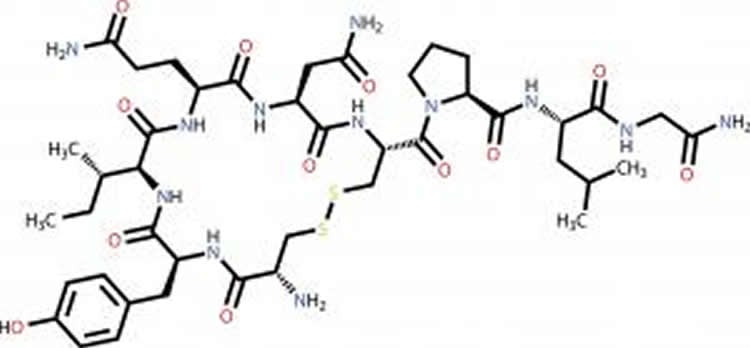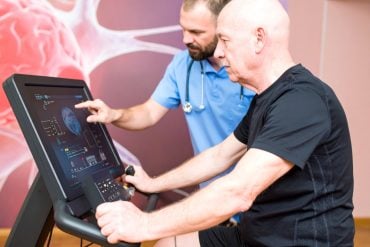Summary: A new measuring method has detected oxytocin at much higher rates in blood serum and plasma than researchers previously thought.
Source: University of Oslo.
Scientists at the University of Oslo have shown that the content of the “love hormone” oxytocin in blood plasma and serum is about 100 times higher than previously thought.
Oxytocin – also known as the “love hormone” or the “cuddle hormone” – has a number of important functions in the body of humans and other mammals.
The hormone is produced in the hypothalamus in the brain, for example in women giving birth – when it helps in creating an emotional connection between mother and child. Hospitals use oxytocin to induce labour or start lactation when necessary.
In the wake of spectacular findings in e.g. rats (where mothers sometimes eat their own children if they lack oxytocin), the study of oxytocin in humans has become “hot”.
The drug is believed to increase empathy and attention towards social cues from others. A study at the University of Oslo in 2012 showed that nasal spray containing oxytocin improves our ability to interpret other people’s facial expressions(link is external).
“However, we don’t know if oxytocin is necessary for emotional connections between people, because it is not possible to block oxytocin in humans. Therefore, it is very important to have precise methods for measuring the amounts of the substance in different individuals”, says Associate Professor Siri Leknes at the University of Oslo’s Department of Psychology.
“But it has been a big problem that we didn’t have a method for measuring the levels of oxytocin in a precise manner”, explains Associate Professor Steven Ray Wilson at the Department of Chemistry.
Therefore, there have been many hot discussions among scientists in recent years. Several reports on the links between oxytocin and human emotions have in fact been unreliable, Wilson adds. On the other hand, reports about the link between oxytocin and behaviour seem to have been more reliable.
Precise measurements of oxytocin
But now, the problem of measuring oxytocin is probably solved. A multidisciplinary research group with members from the Department of Chemistry and the Department of Psychology at the University of Oslo (UiO) has developed and documented a new measuring method, which is already being recognized as more precise than all older methods.
The new method has already been used to prove that the real content of oxytocin in blood plasma and serum in humans is approximately 100 times higher than previous methods suggested. The scientific paper that presents this discovery was published in Nature’s Open Access journal Scientific Reports August 16 2016 and has attracted much attention.
“Oxytocin is a peptide – that is a short protein – with a very special, double function. It acts as a neurotransmitter in the brain, which means that it transmits signals between nerve cells. Oxytocin in the brain is believed to cause such things as increased empathy. But when oxytocin is in the blood, it acts as a hormone that regulates bodily processes”, Leknes explains.
“But without precise methods for measuring, it has been difficult to know if there is a clear correlation between oxytocin levels in the blood and the brain. For example, oxytocin nasal spray or injections introduces the drug into the bloodstream, but how much of the substance is able to pass through the blood-brain barrier and affect the brain? We believe that our measurement method will help to provide new and more accurate answers about this”, Wilson adds.
Oxytocin was almost invisible
The project was initiated by neuroscientist Siri Leknes, who has published many scientific articles on oxytocin but didn’t like that different methods gave different answers to how much oxytocin is contained in human blood. She contacted chemist Steven Ray Wilson, who specializes in measuring substances in the body.
“We joined forces in order to develop a method that could provide accurate measurements of oxytocin, but this was more difficult than you might think. After much work, we found that oxytocin in the blood binds very strongly to several proteins, while only a small percentage is dissolved in blood plasma and serum. This means that most of the oxytocin molecules have been invisible to many measurement techniques”, says Wilson.
Breaking the bond
The breakthrough came when PhD student Ole Kristian Brandtzæg at the Department of Chemistry, who is first author on the article in Scientific Reports, found a technique that could break the bond between proteins and oxytocin.
“Proteins consist of long molecular chains that are folded together in a special three-dimensional structure. Our technique is to “stretch out” the proteins, and this causes them to release the oxytocin, Brandtzæg explains.
“Thus, the total amount in the blood becomes available for analysis, and the amount of “love hormone” can be determined by using mass spectrometry. This technique makes it possible to determine exactly which substances, and the quantities of them, that exist in biological samples”, Brandtzæg adds.

NeuroscienceNews.com image is adapted from the University of Oslo press release.
“When we saw that the total amount of oxytocin in the blood is about 100 times higher than previously thought, it was like getting a small shock. This suggests that many previous findings should be reassessed”, implies Wilson.
The scientists are now wondering about the effects oxytocin might have when it is bound to proteins. Maybe the oxytocin causes the proteins to change their function? Or, could the protein/oxytocin complexes act as a reservoir that can quickly release oxytocin when needed? And: how is the relationship between the amount of oxytocin bound to proteins, and the amount dissolved in the blood? Does an increased amount in blood lead to a proportional increase in protein/oxytocin complexes?
“We don’t know yet, but we sought advice from Knut Fredrik Seip at the University’s School of Pharmacy. We came to the conclusion that the best thing we could do was to measure the total amount of oxytocin. Not only the dissolved part”, says Wilson.
Source: University of Oslo
Image Source: NeuroscienceNews.com image is adapted from the University of Oslo press release.
Original Research: Full open access research for “Proteomics tools reveal startlingly high amounts of oxytocin in plasma and serum” by Ole Kristian Brandtzaeg, Elin Johnsen, Hanne Roberg-Larsen, Knut Fredrik Seip, Evan L. MacLean, Laurence R. Gesquiere, Siri Leknes, Elsa Lundanes and Steven Ray Wilson in Scientific Reports. Published online August 16 2016 doi:10.1038/srep31693
[cbtabs][cbtab title=”MLA”]University of Oslo. “”Love Hormone” Oxytocin 100 Times Higher in Blood Than Previously Thought.” NeuroscienceNews. NeuroscienceNews, 7 November 2016.
<https://neurosciencenews.com/oxytocin-blood-levels-5441/>.[/cbtab][cbtab title=”APA”]University of Oslo. (2016, November 7). “Love Hormone” Oxytocin 100 Times Higher in Blood Than Previously Thought. NeuroscienceNews. Retrieved November 7, 2016 from https://neurosciencenews.com/oxytocin-blood-levels-5441/[/cbtab][cbtab title=”Chicago”]University of Oslo. “”Love Hormone” Oxytocin 100 Times Higher in Blood Than Previously Thought.” https://neurosciencenews.com/oxytocin-blood-levels-5441/ (accessed November 7, 2016).[/cbtab][/cbtabs]
Abstract
Proteomics tools reveal startlingly high amounts of oxytocin in plasma and serum
The neuropeptide oxytocin (OT) is associated with a plethora of social behaviors, and is a key topic at the intersection of psychology and biology. However, tools for measuring OT are still not fully developed. We describe a robust nano liquid chromatography-mass spectrometry (nanoLC-MS) platform for measuring the total amount of OT in human plasma/serum. OT binds strongly to plasma proteins, but a reduction/alkylation (R/A) procedure breaks this bond, enabling ample detection of total OT. The method (R/A + robust nanoLC-MS) was used to determine total OT plasma/serum levels to startlingly high concentrations (high pg/mL-ng/mL). Similar results were obtained when combining R/A and ELISA. Compared to measuring free OT, measuring total OT can have advantages in e.g. biomarker studies.
“Proteomics tools reveal startlingly high amounts of oxytocin in plasma and serum” by Ole Kristian Brandtzaeg, Elin Johnsen, Hanne Roberg-Larsen, Knut Fredrik Seip, Evan L. MacLean, Laurence R. Gesquiere, Siri Leknes, Elsa Lundanes and Steven Ray Wilson in Scientific Reports. Published online August 16 2016 doi:10.1038/srep31693







